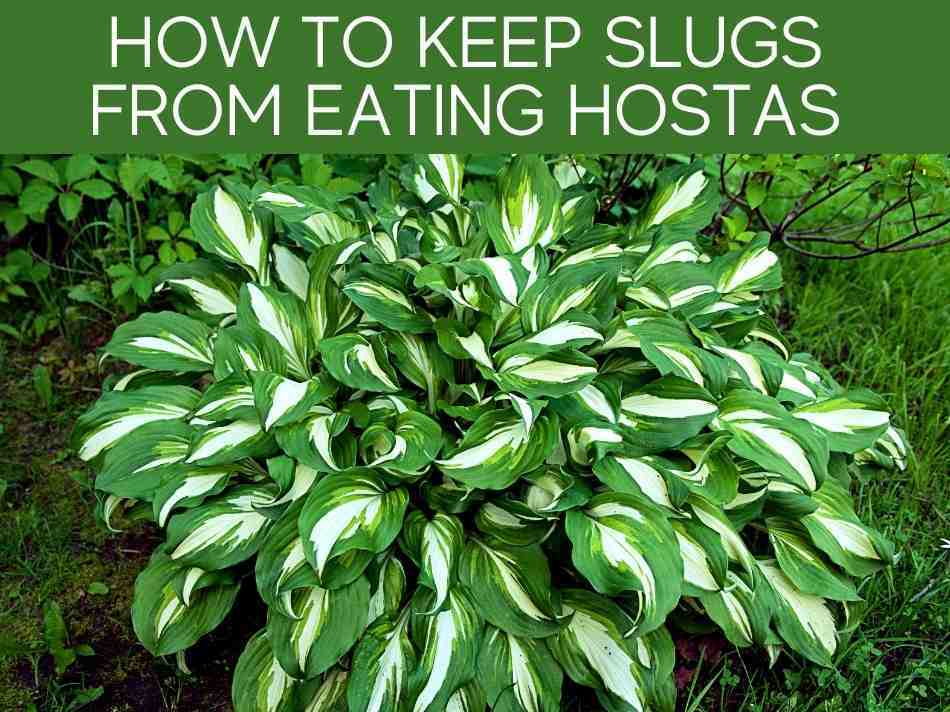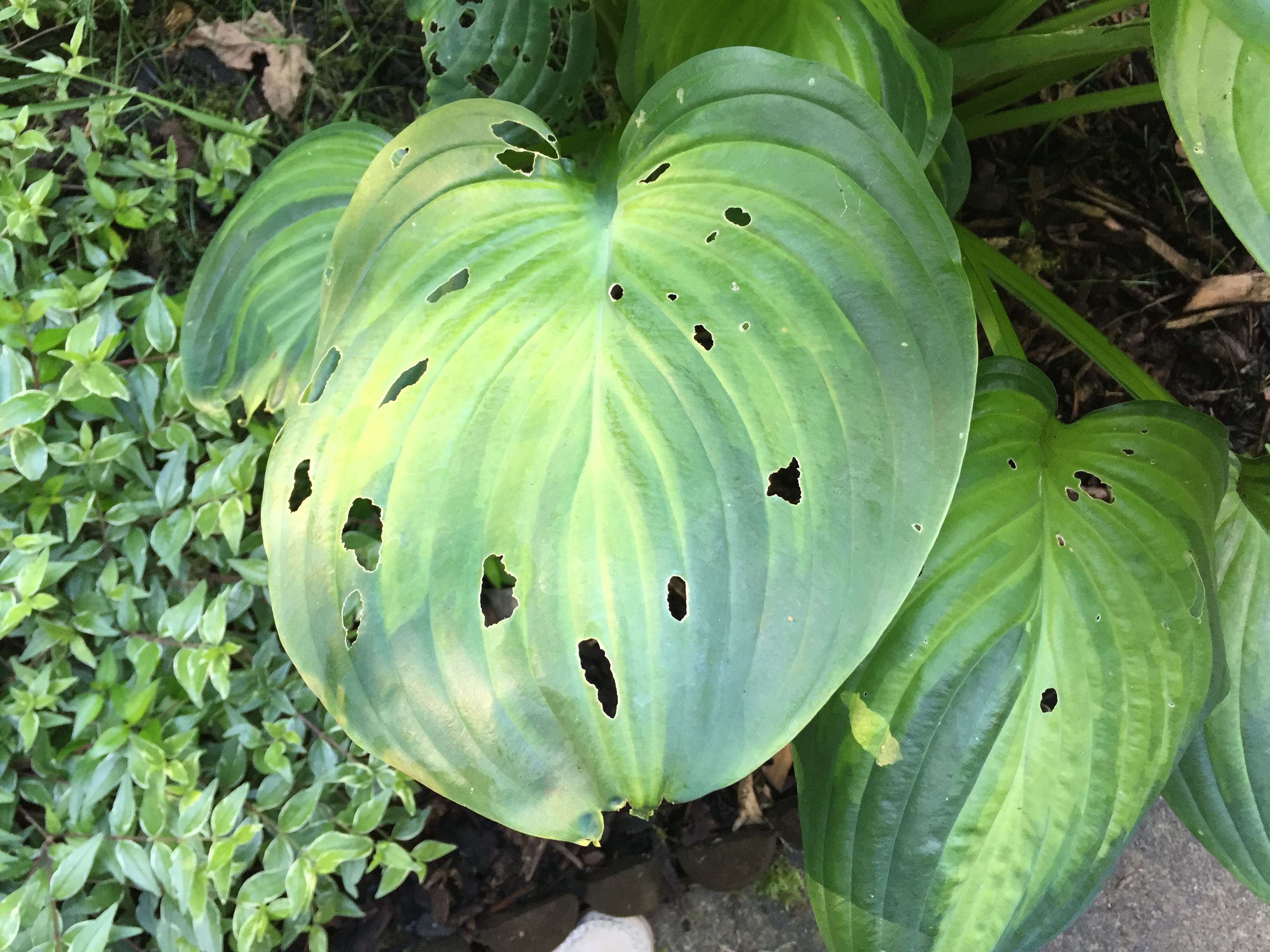
Slugs and snails are the enemy of hosta growers because they adore munching on its succulent leaves and leaving their distinctive shredded holes as they work at night.
To keep slugs out of my potted hostas, I personally have tried every typical tip out there, including copper strips, coffee grinds, and everything in between, but none of these methods actually work.
That is, until I followed the following advice, all of which worked together.
- Vaseline should be applied around the pot’s perimeter (or on elevated feet underneath the pot), then salt should be rubbed into it. Vaseline helps keep the salt in place and prevents it from evaporating. A salt line will deter slugs and snails, protecting your hostas in the process.
- Plant hosta cultivars that are resistant to slug damage, such as “Sum and Substance,” which have thicker leaves that are more difficult for slugs and snails to consume.
- Hostas should only ever be watered in the morning to allow the edges of the pot and the surrounding area to dry before dark, when slugs are most active. This is because moist conditions only serve to attract slugs and snails.
Together, these three actions offer a wonderfully effective method for keeping slugs out of pots and away from hostas that has shown to be more successful than any other approach I have ever attempted.
For further recommended practices to prevent slugs and snails from damaging your hosta plants in pots, as well as details on how to put these suggestions into reality, scroll down.
Table of Contents
Keep Slugs and Snails out of Hosta Pots with Salt and Vaseline
This is the best method I’ve yet seen to keep slugs and snails from chowing down on juicy hosta leaves.
Slugs and snails won’t cross salt (which could kill them by dehydrating them) or dry wood ash. Wood ash is not a long-term deterrent, either, as it loses its potency after rain and is easily blown away in winds.
Since salt will dissolve in water, it appears that it is ineffective as a long-term slug deterrent outside.
The cool technique is here.As the top of the pot is most likely to be in the rain shadow, you can put a ring of Vaseline (approximately half an inch wide) on the exterior.
The next step is to rub the salt into the Vaseline all the way around the pot’s edge. Vaseline will keep the salt in place and prevent rain from washing it away.
This will create an impassable barrier for the slugs, stopping them from crawling up the pot to attack your potted hostas in the middle of the night once they smell the salt, which is held in place by the Vaseline.
This straightforward strategy has shown to be a highly effective means of addressing the most common issues gardeners encounter while producing hostas.
It should be noted that you will need to periodically maintain the salt and Vaseline barrier because rain, ice, snow, and other moisture-causing factors progressively dissolve some of the salt and weaken the slug barrier.
However, this strategy can last for many months before requiring changes as long as the line of Vaseline and salt is in the rain shadow of the pot.
As an alternative, you can raise a rectangle or square pot off the ground using “feet” or stones and create a barrier of Vaseline and salt around the feet if the pot does not have a rain shadow. The feet can be shielded from rain by being underneath the pot, allowing the salt to remain inactive and useful as a slug deterrent for longer.
The benefits of salt over pellets or other slug traps or repellents include:
- Regarding appearances, the salt and Vaseline approach is quite covert. The barrier won’t detract from the appearance of the lush, decorative hosta leaves because you can’t see it unless you’re up close to the pot. Other techniques, like beer traps, or slug pellets are far more overt and unattractive.
- Slugs will become dehydrated if salt is put on them (via osmosis). A slug will detect the salt and retreat untouched if it is set up with Vaseline around the outside of the pot. However, slugs and snails that consume pellets will eventually die and transfer the chemicals to birds, raccoons, hedgehogs, and any other natural predators of garden slugs, which will ultimately have a negative multiplier effect on the ecology of the garden.
- Vaseline and salt are reasonably inexpensive, the method is simple to use, and there are no unfavorable effects on wildlife.
Slug Resistant Hostas for Pots

The most well-known and commonly accessible of these hostas are “sum and substance” and “halcyon,” which are huge, hardy hostas with lovely leaves. It is said that “Sum and Substance” is the hosta that is best at withstanding slugs.
In comparison, Hosta ‘Krossa Regal’ is a smaller hosta that matures to a height and width of 24 inches. This cultivar’s resistance to slugs is facilitated by its thicker, waxier leaves.
Because they have thicker, waxier, and more robust leaves that are harder for slugs and snails to eat, these hostas fight slugs more effectively than others.
Hostas that are resistant to slugs and snails are another excellent preventive method that will lessen the likelihood of slug and snail prevention.
Water Hostas in the Morning (Not in the Evening)

Since many gardeners water their plants in the evening, the hostas, soil, and ground will be soggy the next evening.
Because they are most active in moist environments and like to emerge at night, slugs and snails are more likely to target your hostas and leave their distinctive holes in the leaves.
Hostas should always be watered in the morning so they have water for the day and so the ground and area surrounding your pot can dry out a little before nightfall. This will lessen slug and snail activity on your hostas when used in conjunction with the other remedies.
More Best Practices
Additional suggestions for preventing slug and snail predation on potted hostas include:
- Avoid leaving long grass in the vicinity of your garden. Long grass becomes the perfect hiding place for slugs during the day since it provides them with cover, moisture, and other favorable conditions. Ideally, strim along the borders and margins of the lawn, which are frequent hiding places, and cut your grass once a week. Around your garden, the less slug habitat there is, the better.
- Clean up the dead foliage in and around planters. Slugs’ natural function is to eat decomposing organic waste, particularly leaves and rotten wood. Make sure that dead leaves don’t pile up in garden corners for an extended period of time in the fall because this could create alternative sources of food or shelter for slugs and snails.
- Encourage the natural predators of slugs. Slug populations can be easily regulated by birds, hedgehogs, raccoons, badgers, frogs, and many other creatures. Particularly effective slug predators are birds. In most gardens, it’s extremely simple to find a spot for a bird box, and you’ll be helping to conserve wildlife at the same time.
- Ensure the health of the hostas. Hostas are at there most resilient when they are cared for. So make sure they are planted in high-quality potting soil, and on hot days, keep the soil just barely moist. Following the fertilizer manufacturer’s guidelines is important since too much fertilizer may cause hostas to wilt and grow soft and sappy, which is perfect for slugs.
Key Takeaways:
- It takes numerous coordinated efforts to successfully stop slugs and snails from consuming hostas.
- The best method is to form a line of Vaseline around the pot’s perimeter and then massage salt into it to keep it in place.
- The salted barrier will not be overcome by slugs. To prevent the salt from dissolving, the barrier should be placed at the bottom on raised feet or around the top of the pot out of the rain shadow. This method, which doesn’t kill wildlife like slug pellets do, can be successful for months before you need to add additional salt or Vaseline.
- Hostas that are resistant to slugs and snails, like “Sum and Substance,” are less likely to be attacked by slugs because of their thicker leaves.
- In order for the pot and the surrounding ground to dry up before dusk, when slugs appear, water hostas in pots in the morning.
- Mow the lawn frequently and remove any dead leaves to reduce possible slug and snail habitats.
